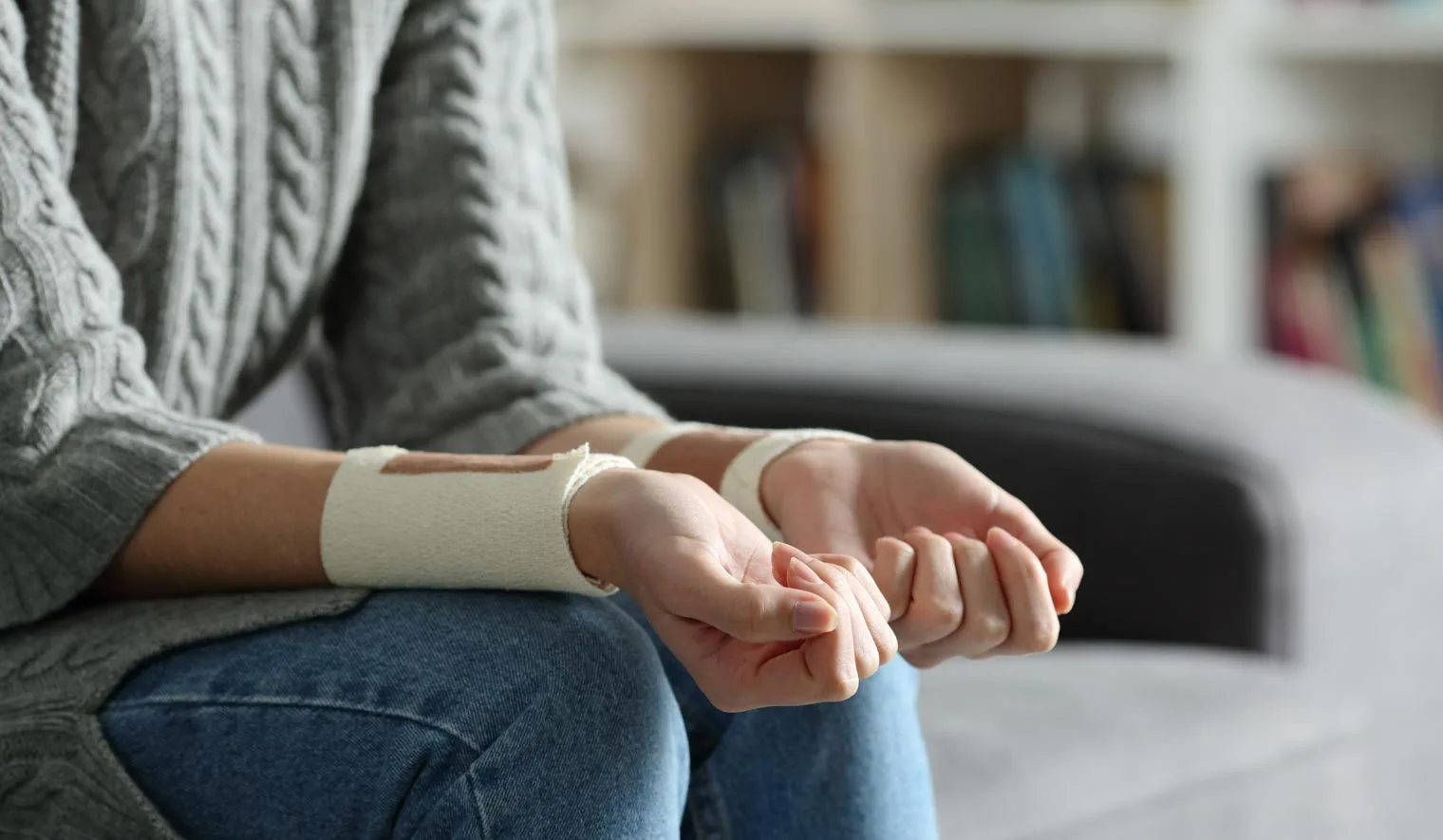What to Know About Self Harming Behavior and Its Treatment
Table of Contents
Self harm is a serious issue among people of all ages, even if the end goal is not suicide. According to one study, 8 percent of youth engaged in non-suicidal self-harm but it can also impact adults. After extensively turning to this method of coping with negative feelings time and again, you may find that you (or someone you love) have developed an addiction to self-harm.
Emerald Isle Health and Recovery in Arizona has the skilled clinicians you need to combat addiction to self harm. Whether it stems from an underlying mental health concern or stands on its own as an addiction, we have the resources to help you stay clean and to cope with cravings.
What Exactly is Self Injury?
When someone struggles with a variety of mental health conditions including a serious case of depression or anxiety, they may choose to turn to self-injury to cope. Sometimes referred to as self-harm, it can encompass a variety of behaviors. Most commonly, you may find that someone cuts the skin. However, this is far from the only type of self-injury.
Other forms of self-harming behavior can include:
- Punching themselves or other objects with the goal to inflict pain
- Burning
- Pulling out hair
- Breaking bones
- Causing bruises
Self-harm behaviors like these are meant to offer a sense of release from strong emotions. It can act as an antidote to the internal pain that someone feels. They want to discontinue feelings of sadness, loneliness, or even anger. It can accompany issues like substance abuse, worsening when someone is under the influence.
For someone who struggles with behavioral addictions to some of these forms of self harm, it is powerful though negative coping skill.
It is important to keep in mind that for many people, self-harm does not stem from a desire to commit suicide. This non-suicidal self-injury is used to cope with strong urges and emotions rather than a desire to end their life.
Free Mental Health Assessment
When Self Harm Overlaps with Mental Illness
Oftentimes, self-harm does not actually occur within a vacuum. Many people use self-injury as a means to cope with other mental health concerns. It can become so chaotic in their minds that they feel they have no outlet except to harm themselves. While some of the most common overlapping mental illness issues include anxiety or serious depression, they are far from the only ones.
Self-harming behavior can also overlap with other disorders such as borderline personality disorder. In fact, this condition is one of the most frequently observed conditions that contribute to self-harming. Among those who have this diagnosis, the rates of self-harm are extremely high, coming in at around 50 to 80 percent.
With that being said, researchers found that most of the self-harm could be classified as non-suicidal self-injury. It was actually viewed as a protective factor against suicidal intent. Self-harming behavior broke the spell of dissociation and helped them to feel alive and connected to their bodies again.
Can Self Harm Be Addictive?
If you or someone you know engages in non-suicidal self-harm, you might realize how difficult it is to put a stop to the behavior. It allows you to cope with negative emotions and difficult situations, but can it truly be addictive? Research is pointing to the idea that self-injury is indeed one of many behavioral addictions.
According to a recent study, researchers found that self-harming could be viewed in the context of addiction language. They administered a test to determine if adolescents who were currently receiving psychiatric treatment were experiencing cravings for the release of self-harm.
While the overall scores were lower than those expected from an individual with substance use disorders, they were quite high in the area of negative emotions.
Another review of the literature surrounding self-harm and suicidal behavior found that both could be viewed through the lens of addiction language. With this in mind, it could radically shift the current treatment model for self-harming behavior.
The Mechanics of Self Harm Addiction
Even if you have no issues with substance abuse, you might still find that you have behavioral addictions. Non-suicidal self-injury is one of those addictions that can come packaged with some of the same languages as substance use disorders. People who engage in self-harming often refer to issues such as “cravings” or “relapse” when they engage in this harmful behavior.
The question is: how does the body actually become addicted to self-harm?
Self-Harm as a Coping Skill
Non-suicidal behavior such as self-injury is often used as a coping skill, much in the same manner as those who engage in substance abuse. When negative emotions arise, someone may turn to self-harm to cope with those strong feelings. They may struggle with the idea of coping with this crutch and can experience strong cravings if they try to stay away from it.
For most people, behavioral addictions are about finding a way to temper strong emotions. To this end, self-harm is an extremely powerful tool. It takes the psychic pain of the emotions and translates it into physical pain. The goal is to obtain some relief from the feelings that they no longer want to experience. Self-injury can tie them back to the body.
Addiction to Endorphin Release with Self Harm
However, it is also addictive on a chemical level. When the body is injured through cutting, burning, or another method, the body releases endorphins. This is the same idea as when your body releases endorphins after a long run or a heavy workout in the gym.
The goal is for the body to mask the pain that it feels — and self-harm is certainly capable of causing this level of pain.
Unfortunately, this rush of endorphins can prove to be quite addictive. Your body will crave the release of feel-good chemicals when you struggle with an influx of negative emotions. Because non-suicidal self-injury can trigger these endorphins, the body, and brain may convince someone that they need to engage in self-harming behavior to feel this “high.”
As a result of the endorphins released in the body, a person often finds that they feel better after harming themselves. This can create a powerful feedback loop that leads them to continue self-harming in order to experience this relief from extreme pain and emotion.
Unfortunately, these endorphin releases do not last. In their wake, many people start to feel the real effects of their self-harm including shame and guilt.
Getting to the Bottom of Treatment for Self Harm Addiction
If you or someone you know engages in non-suicidal self-injury, then it is time to seek treatment for the condition. This negative reinforcement for when someone has an influx of negative emotions should be treated as soon as possible. Even if the goal is not to end their life, self-harming can lead to a serious addiction just like substance use disorders.
As a result, someone who engages in self-harming may find that their treatment has some overlap with substance abuse. Emerald Isle Health and Recovery can help you take the first steps toward healing and treatment with some of these approaches.
Tolerating Negative Experiences or Emotions
One of the first aspects of treatment for non-suicidal self-harm is helping to put unpleasant emotions in context. Learning to tolerate the discomfort that comes with the disappointments and challenges of life is crucial. This type of distress tolerance is a core component of dialectical behavior therapy or DBT.
As you practice distress tolerance, you will gain strength when it comes to sitting with and experiencing these feelings. You will become accustomed to the uncomfortable feeling that comes from these emotions and you won’t need to turn to self-harm to handle it.
Instead of immediately turning to self-injury in order to cope, you will learn that these emotions will eventually pass. Over time, you will become used to sitting with and even learning from these negative experiences without using self-injury as a coping skill.
Finding Alternative Coping Skills to Replace Self Harm
Of course, simply managing your tolerance for distress is only part of the battle. When these negative feelings arise, you need to come up with a plan for how you will manage them and keep them in check. To this end, you will need more healthy coping skills or activities that you can do in the place of self-injury.
For example, you may find that certain activities are a great distraction from your desire to harm yourself. You could reach out to a friend over the phone, go get a cup of coffee, take a long shower, or go for a run. Even simple things like listening to a favorite song or playing a board game can be beneficial.
No matter what makes you feel good, you can find activities that keep you from turning to negative coping skills like self-harm. Use them to manage your distress tolerance and you will find that you can put off non-suicidal self-harm for a little while longer.
24 Hour Mental Health Hotline
Setting Short-Term Goals to Prevent Self-Harm
If you also have substance use disorders or are familiar with the Alcoholics Anonymous program, then you may understand the importance of setting short-term goals. At the end of each meeting, AA programs typically give out chips to reward certain milestones of sobriety. They start with the very modest achievement of the first 24 hours sober.
The first goal is within reach, though it is rarely simple to reach it.
In the same way, you can combat self-injury by setting short-term and realistic goals to keep you from hurting yourself. Abandon the idea that you can never turn to self-harm again for the rest of your life. This is a great goal and an achievable one, but it is easier to start small: refrain from self-harm for an hour, a day, or a week.
This allows you to build up experience coping with distress. Plus, it gives you a sense of accomplishment for reaching your goals quickly. This can be a powerful incentive to keep the chain going.
Cognitive Behavioral Therapy for Self Harm
In addition to the things that you can do on your own to combat self-harm addiction, you also need the help of a trained counselor or therapist. Cognitive behavioral therapy (CBT) is a solid component of a robust treatment plan. Look for a program like those offered at Emerald Isle Health and Recovery.
CBT focuses on the triad of how your thoughts and feelings lead to action. For example, you might think about what happened during the day and realize that you are having a difficult time coping. As a result, you might feel depressed or anxious about those feelings. Those feelings flood the body and lead you to want to find a release that will allow you to feel better.
The result is that whenever you experience those negative thoughts and emotions, you become accustomed to engaging in self-injury.
A trained CBT provider can help you interrupt this habit loop. They can assist you with modifying your thoughts when a negative experience comes up. If you are able to change your thoughts, it often impacts your feelings and the actions that you take to cope with those feelings.
If you can modify your thoughts and feelings, it becomes more and more likely that you can turn to positive reinforcement instead of self-harm.
Medication for Underlying Mental Health Conditions
If you find that your self-harming behaviors are the result of underlying mental health concerns, then you may want to consult with a psychiatrist. Many people who present with non-suicidal self-harm have depression or anxiety that contributes to their self-harm addiction. Even conditions like borderline personality disorder can benefit from medication.
Pharmaceutical help for your underlying mental health issues can resolve some of the feelings you have. When you can eliminate the contributing factors to your self-harming behaviors, you can work toward staying clean from self-harm altogether.
Keep in mind that medication may not be right for everyone. This is highly dependent upon your treatment plan with a team of skilled clinicians like those found at Emerald Isle. You should make sure to understand what the medication promises to do and how to take it responsibly before you decide to use this method.
Family Therapy for Increased Support
In addition to individual therapy sessions, it might be a good idea to involve your family or loved ones in your treatment plan. This gives them better insight into how you think and how they can best support you. It offers a safe space for sharing difficult emotions with those who love you.
Plus, family therapy allows you to address any serious issues that contribute to your addiction. You will have the help of an objective third party to moderate your discussion to keep things productive. This is often enough to keep the conversation focused on the topic at hand (your self-harm) and prevent it from devolving into chaos.
Group Therapy for Peer Support
While you may focus in one-on-one therapy sessions on the basic tenets of CBT and DBT, you may also benefit from group therapy. This gives you the option of peer support from others who know what you are going through. Peer support can be a powerful way to help you feel less alone in your struggles and self-harm addiction.
Oftentimes, peer support groups are moderated by a licensed clinician who can help to keep the conversation focused on healthy alternatives to self-harm.
As a bonus, it also allows you to develop relationships with other people who can talk with you when you find yourself craving self-harm. You will build a robust support network of people you can reach out to when the need arises as opposed to waiting for your next therapy session with bated breath.
Inpatient Treatment for Increased Safety and Help
Of course, sometimes finding positive coping skills to combat non-suicidal self-injury is not going to be enough. Combatting an addiction often means that you will need a bit more help than simply outpatient treatment. If you are unsure whether you can stay free from self-harm in the near future, it might be best to book an inpatient stay.
Emerald Isle Health and Recovery can help you take the first steps toward recovery from non-suicidal self-injury. You will be in a safe environment with the assistance of staff and peers 24/7. This makes it impossible for you to engage in self-harm.
However, if your self-harm is also part of suicidal ideation, then you definitely need the immediate help of a professional team. Allow us to keep you safe while you take the first steps on your path to healthy and happy living. You can focus solely on your treatment plan instead of wondering whether you will be able to keep yourself safe.
Inpatient treatment is a great way to also receive treatment for other mental illnesses such as borderline personality disorder or substance use disorders at the same time.
Outpatient Treatment for More Flexibility
If you graduate from an inpatient program, you might find that you still need more assistance. Going back to your daily life can prove to be quite a challenge, especially if your primary coping skills have been stripped away. You will need to consider enrolling in some form of outpatient treatment to continue your path to healing.
Outpatient therapy can take several forms.
Partial Hospitalization
Immediately upon discharge from inpatient, you might choose to step down into partial hospitalization. This allows you to spend your days in a hospital setting with trained staff to support you. However, you will have the freedom to go home in the evenings and nights to practice the skills that you have learned and are learning.
This gives you the structure that you may need for the daytime hours, which are often the hardest to get through with addiction. At night, you can practice what you have learned and enjoy the freedom to spend uninterrupted time with your family or loved ones.
Outpatient Therapy
If you no longer need the level of support offered by partial hospitalization, outpatient services can be even more flexible. You can come and go as you please, as long as you attend all of your scheduled sessions. You can receive individual therapy, group therapy, and even activity therapy through an outpatient model.
Many people are able to return to work around their scheduled appointments. This makes it the least obtrusive way to pursue treatment, but it may not be the first step. Consider whether you could benefit from the safety and structure of inpatient or partial hospitalization before you segue into an outpatient program.
Immediate Placement for Mental Health Treatment
Taking the First Steps Toward Recovery with Emerald Isle
If you are struggling with an addiction to self-harm, with or without suicidal ideation, then you need to reach out for help. You do not need to battle this condition on your own. Help and healing are within reach for everyone at Emerald Isle Health and Recovery.
We offer a range of services that can help you combat your addiction from inpatient services to more flexible outpatient and partial hospitalization options. With a team trained in both CBT and DBT, we offer all of the leading treatments for addictive behaviors, including self-harm.
No matter where you are on your journey with self-harm, we can help you take the first steps toward recovery. With our state-of-the-art treatment facility, you can rest assured knowing that you are in the best possible hands.
Reach out to us today to learn how we can help you with your recovery from non-suicidal self-injury and start a new chapter in your life now!





